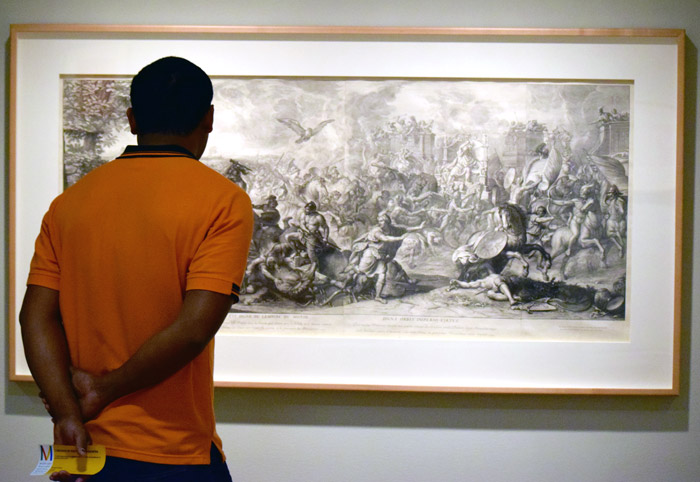In line with the upcoming major exhibition Pompeii, the Musée des Beaux-Arts (MBAM) offers art and history lovers The Recovery of Antiquity. This discovery exhibition is situated in a secluded area on the lower level of the Jean-Noël Desmarais Pavilion, and is composed of a selection of paintings and drawings from the museum’s collection. Albeit small, The Recovery of Antiquity is somewhat a brief history lesson for its audience, providing short explanations for the fifty-something graphic works in the gallery.
The first room of the exhibition showcases classicist works depicting Ancient Rome from the 17th and 18th centuries by influential artists of the time, such as Greuze, Audran, Girodet, and many others. Most of the drawings are done either in pen and ink, red chalk, or pencil, which adds a somewhat modern touch to an exhibition focused on antiquity. Each piece depicts segments from Roman mythology and history in a clear and simple manner. The drawings are detailed and structured, and give off a slightly dry vibe. These works create a curious and almost contrasting atmosphere in this small gallery dedicated to the ancient world—a world that most people are used to seeing as colourful and grandiose, almost magical.
Although antiquity was not truly recovered in Renaissance-era Italy and France as the title of the exhibition suggests, some important archeological discoveries certainly renewed the artists’ worship of this particular era. Indeed, the description at the entrance to the second hall of the gallery tells the visitor that the discoveries of Herculaneum in 1738 and of Pompeii in 1748 refueled the enthusiasm and artistic interest towards Ancient Rome. This new knowledge led to the emergence of influential Italian artists, such as Giovanni Battista Piranesi and his important successor, Gioaccino Rossini.
Both Piranesi and Rossini were inspired by the grandeur of Ancient Rome, which they explicitly illustrated in their work. Piranesi inspired Rossini, and a number of other followers, by his exquisitely detailed etchings. The second part of the gallery is filled with works by both these artists, in which they illustrated the ruins of Roman temples and other monuments. Each piece requires close examination on the part of the visitor, as the artists put an extreme amount of depth and precision to each little corner of their drawings. Although they seem dark and complex at first, they are remarkable in their own way, as each detail was given the artist’s full and meticulous attention; from the tiny humans walking up the stairs of the Coliseum, to the carefully sculpted columns of destroyed temples. Piranesi’s and Rossini’s works depict the majestic and monumental ruins of Roman temples in juxtaposition with elements from the artists’ era, showing just how feeble and unimportant the artists believed their contemporaries were compared to the grandiosity of the Roman heritage.
The exhibition itself is quite short, but it does leave the visitor with a pleasant aftertaste from the intricately detailed drawings and an anticipation for the upcoming major exhibition on Pompeii. It is a glimpse into the history of artistic movements from Renaissance throughout Neoclassicism. The exhibit portrays small but nonetheless intriguing works, and guides the audience towards a better understanding of how the simplicity of Roman art shaped cultural movements throughout centuries.
The Recovery of Antiquity runs from Jan. 12 to June 26 at the Musée des Beaux-Arts (1379 Sherbrooke Street West). Admission is free for people under the age of 30.










Pingback: Explorator 18.41-42 ~ February 14, 2016 | Explorator